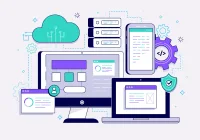Data interoperability is a fundamental challenge in healthcare, particularly in long-term care (LTC) settings, where patients require extended, continuous care. Many LTC facilities struggle to integrate disparate data sources, limiting their ability to align clinical, operational and financial goals within a value-based care (VBC) framework. The lack of seamless data exchange restricts patient care quality, increases costs and hampers revenue opportunities. By leveraging enterprise data management (EDM) systems, LTC providers can overcome interoperability barriers, enhance care coordination and improve patient outcomes while driving efficiency and financial sustainability.
Integrating Disparate Data Sources for a Unified Care Approach
LTC patients often receive care from multiple healthcare providers, including specialists, hospitals and primary care physicians. These interactions generate vast amounts of data stored across various electronic health record (EHR) systems, claims databases and external platforms. However, these fragmented systems create significant challenges in accessing and utilising patient data effectively. Without a unified data ecosystem, care teams struggle to obtain accurate, real-time insights, leading to inefficiencies and potential care gaps.
Implementing sophisticated EDM systems allows LTC facilities to consolidate and standardise data from multiple sources, creating a single source of truth. By ensuring that clinical information is harmonised and accessible, these systems enhance decision-making processes, reduce redundancies and support a more patient-centric approach. Additionally, interoperability solutions facilitate real-time data exchange, enabling care providers to track patient histories, treatment plans and medication regimens seamlessly across the healthcare continuum.
Enhancing Patient-Centric Data Integration for Continuity of Care
Many LTC residents have complex and evolving medical needs, necessitating a longitudinal and holistic view of their health history. However, incomplete or outdated records can hinder providers' ability to deliver optimal care, leading to potential errors, redundant procedures and fragmented care experiences. Ensuring continuity of care requires an integrated dataset that includes both historical and current medical data, ensuring that every transition in the care journey is well-informed and coordinated.
Must Read: Achieving Healthcare Interoperability: Challenges and Opportunities in 2025
Advanced EDM tools facilitate the enrichment and linkage of patient data, allowing providers to access a comprehensive view of each resident’s needs. This approach ensures that critical information follows patients throughout their care journey, minimising the risk of miscommunication or oversight. Additionally, by integrating social determinants of health data, LTC facilities can adopt a more proactive approach to care management, addressing underlying factors that impact health outcomes. Such integration fosters improved decision-making, enhances care continuity and ultimately leads to better patient experiences.
Leveraging Predictive Analytics and Security for Better Outcomes
Beyond integrating disparate data sources, modern EDM platforms also empower LTC providers with advanced analytics, including artificial intelligence and machine learning-driven insights. Predictive analytics enable care teams to identify potential health risks, anticipate complications and implement preventive interventions. By analysing patterns within patient data, these tools facilitate proactive care planning, reducing hospital readmissions and improving long-term health outcomes.
Furthermore, as LTC facilities increasingly rely on digital solutions for interoperability, safeguarding patient data becomes paramount. Secure EDM systems ensure compliance with regulatory requirements while protecting sensitive information from breaches and unauthorised access. Implementing stringent security measures while enabling necessary data sharing ensures that LTC facilities maintain trust, transparency and regulatory adherence while improving patient care quality.
Overcoming data interoperability challenges is essential for LTC facilities striving to enhance care quality, optimise operational efficiency and align with value-based care objectives. By implementing robust enterprise data management systems, these facilities can achieve seamless data integration, improve care coordination and support predictive analytics for better patient outcomes. Interoperability-driven solutions not only enhance clinical decision-making but also enable LTC providers to deliver more personalised, efficient and cost-effective care. Embracing technological advancements in data management will be critical in elevating long-term care and ensuring positive patient experiences.
Source: Health IT Answers
Image Credit: iStock










